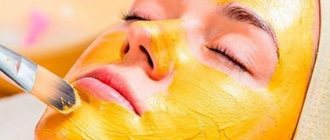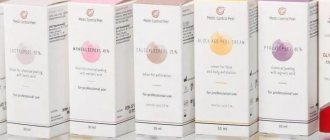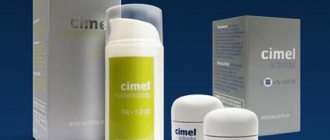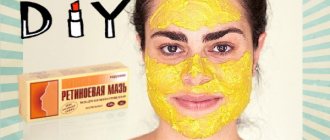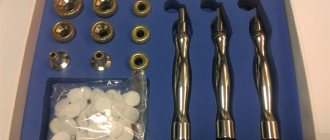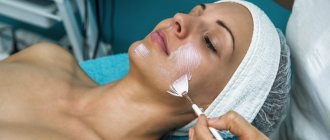From this article you will learn:
- What is retinoic yellow peeling?
- What are the indications and contraindications for retinoic yellow peeling?
- Can it be done at home?
- How does the procedure take place in the salon?
- Are there possible side effects?
- How much does retinoic yellow peeling cost?
Today, not a single woman who takes care of her appearance and constantly visits a beauty salon can do without peeling. It is necessary for anyone who needs to quickly eliminate fine wrinkles. There are several types of this procedure. In this article we will look at one of them – retinoic yellow peeling. Below you will find out what this type is, in what cases it can be done, and when it is contraindicated, how often you need to visit a beauty salon to undergo the procedure.
What is retinoic yellow facial peeling?
Everyone knows that peeling is the process of removing dead skin cells using chemicals. In the beauty industry, it is customary to distinguish three methods of peeling : superficial, medium and deep.
.
Superficial peeling only removes particles of skin cells. The second method has a stronger effect, as a result of which the rejuvenation process occurs. Deep peeling
– this is already the most serious procedure, when we get rid of both dead cells and partly living ones.
Recommended articles on the topic:
- Facial mesotherapy procedure: pros and cons
- Beauty injections: types of drugs, reviews
- Placental therapy is the secret of eternal youth
Retinoic
yellow peeling
can be both superficial and medium. In the foreign market, it has long established itself as a high-quality and reliable remedy for solving most facial skin problems. This method has just begun to appear in domestic beauty salons, and many women have yet to appreciate its benefits. In the future, the number of people wishing to undergo the retinoic yellow peeling procedure will continue to grow.
Peeling is called yellow because after it such a shade remains on the top layer of the epidermis. But the skin becomes yellowish only for a short period of time. In most cases, only one procedure is enough to improve the condition of the face. The decision on the required number of sessions always remains with the doctor under whose supervision they are carried out. If necessary, the doctor can prescribe a full course of peeling. Then the patient will have to undergo from six to ten procedures with a break between each of at least ten days.
In cosmetology, retinoic yellow peeling comes in two types. The first of them uses retinoic acid of synthetic origin
. According to the method of penetration, it belongs to the middle, and at the same time has a gentle effect on the skin. After the procedure, she recovers in just a couple of days. Due to this, this type is popularly called the “weekend procedure.”
After completing the session, a woman may feel a slight tightness on her face. The problem is solved with the help of special moisturizers. Also, the skin will have a rich pink color for two days. It will begin to peel off, but after the rehabilitation period it will become smooth and tender.
The main clients who are recommended to pay attention to yellow peeling are people who are already twenty-five years old. Sometimes a similar procedure is prescribed to younger girls if it is necessary to remove marks or scars from acne.
Two weeks before the session, the preparatory stage begins. It consists of starting to use a product that contains retinoic acid of synthetic origin. It is the main component of the peeling. Thanks to two weeks of use, the skin gets used to it, and doctors become confident that the substance does not cause any adverse reactions.
The procedure begins by treating the skin with a solution of glycolic acid, followed by the application of retinoic acid. The components act on the surface of the skin for several minutes and then penetrate deep into it. At the end of the session, the composition is neutralized.
The second type of yellow peeling is using natural retinol.
It can be performed more often than the first option (synthetic acid-based peeling is recommended to be done once every six months). This type of peeling has a milder effect, so it can be used every month.
The composition includes natural retinol, which is obtained from the tropical urukum bush growing in the Amazon. This substance makes it possible to carry out only superficial peeling, the main component of which is kojic acid.
Read material on the topic: Laser facial skin rejuvenation: useful tips and recommendations
Features of yellow peeling:
- Yellow;
- Everyone is used to the fact that acid peels are left on the skin for only five minutes. And this look needs to be kept for ten whole hours;
- Due to the duration of the procedure, cosmetologists do not recommend doing yellow peeling more often than once every six months;
- After removing all the influencing substances from the face, the skin turns red, then begins to peel, and then peels off greatly. This is normal and goes away very quickly.
Retinoic yellow peeling: indications and contraindications
Indications
for the use of retinoic yellow peeling:
- The appearance of small wrinkles;
- Heavy pigmentation caused by long exposure to the sun;
- Loss of elasticity and firmness;
- Insufficient collagen production;
- Acne;
- Skin aging;
- Insufficient skin hydration;
- Hyperkeratosis;
- Need for bleaching;
- Hyperpigmentation.
The retino yellow peel also has several other benefits. It has a lifting effect, gives the skin a smoother appearance and improves relief, removes any impurities from the surface, and stimulates anti-inflammatory processes. The external condition of the skin improves and a healthy glow appears.
Contraindications
for the use of retinoic yellow peeling:
- Allergic reactions that may be caused by the use of retinol;
- Incompatibility with other medications: this peeling can only be done six months after taking Roaccutane.
- The presence of viral infections, which, together with retinoids, can cause a herpes rash;
- Liver disease, as well as previous hepatitis;
- Increased skin sensitivity, which may be indicated by problems such as atopic skin reactions, seborrheic dermatitis, eczema;
- Photosensitivity – high sensitivity to solar or other radiation with a UV component;
- Pregnancy and planning in the coming year, as well as the lactation period;
- Presence of warts.
Precautionary measures
To avoid complications and increase the duration of the effect, there are certain prohibitions during the rehabilitation period, so you cannot:
- sunbathe;
- visit the sauna, solarium, swimming pool;
- dye eyebrows, eyelashes, hair;
- use cosmetics containing retinol, alcohol, fruit acids;
- perform any hardware procedures;
- tear off lagging particles of epithelium.
Despite the delicacy of cleansing, side effects may occur after retinol peeling:
- itching;
- burning;
- discomfort;
- feelings of tightness;
- swelling;
- mild hyperemia.
Contraindications:
- violation of skin integrity;
- dermatological diseases;
- exacerbation of herpes;
- taking retinoids;
- planning conception, pregnancy, lactation;
- allergy to the components of the composition.
Buyanov Sergey Yurievich (Expert Doctor):
The effect of synthetic retinol is dangerous for the fetus, as it can cause irreversible changes in tissue formation and organ development. The absorption of retinol during local procedures is insignificant, however, it is better to avoid retinol peeling during pregnancy.
Why chemical peels (retinoic yellow) are in great demand
Safety
The body will not negatively accept retinoic acid because it is similar to vitamin A. Other acids included in the peel only enhance its effect.
Efficiency
Most experts are of the opinion that it is best to start the rejuvenation process with this type of peeling. The result after two procedures lasts up to four months, which in itself is equal to the effect that a course of ten sessions of peeling with glycolic acid gives.
Gentle impact
The Superficial Retinoic Yellow Peel provides effective results similar to those achieved with a Medium Peel. And at the same time, the impact occurs in a more gentle way.
Short recovery period
Everyone knows that the usual time for recovery processes is one to two weeks. After undergoing the yellow peeling procedure, the skin takes on a healthy appearance in one to two days. Of course, peeling and redness will appear during this period. This is a normal skin reaction to the use of chemicals. But after 48 hours the face will be completely fine.
But it is always worth remembering that each case is individual. And in order to avoid disruption of plans, it is not recommended to resort to such procedures at the very last moment. For example, a cosmetologist will not conduct a peeling session if the client has just returned from vacation and has a fresh tan.
Read material on the topic: Facial mesotherapy procedure: pros and cons
When can you start using creams and ointments?
After the peeling procedure, swelling, peeling, crusts are visible, the skin begins to heal.
Attention! During this period, it is allowed to use only medicinal creams and ointments with anti-inflammatory and wound-healing properties, which are recommended by a cosmetologist. During the first 7 days, cells actively divide, new fibers are formed, which requires moisture and nutrients. At this stage, it is necessary to use products that help wounds heal, soothe inflammation and soften the skin.
On the 3rd day, apply a moisturizer suitable for your skin type to your face, which is tight with dehydration. After 5-7 days, moisturizing with the help of natural masks and decoctions, and the use of nourishing cream are allowed.
Important! If peeling was done in winter, use a nourishing cream more often than a moisturizer.
What is the effect of medium retinoic yellow peeling?
Retinoic acid, which may be called tretinoin, is the active form of retinol (or vitamin A). Found naturally in plant foods and animal sources. It is able to form bonds with nuclear receptors, with the help of which it triggers a cellular response. It is important to know that almost all cells in the body are sensitive to retinoic acid. To prevent the accumulation of tretinoin in tissues, as this causes side effects, use a mask with a high content of this substance. It needs to be applied once every couple of weeks. As a result, the epidermis will be renewed at the cellular level. Externally, this will be expressed in characteristic peeling of the skin.
Cosmetologists conducted studies that revealed the following pattern: five yellow peeling procedures done every one week are equal in the results achieved to using the cream for six months. It has also been proven that the chance of any adverse symptoms occurring is extremely small. During peeling, retinoids do not harm the skin, do not destroy living cells and do not lead to protein coagulation.
As a result of the influence of active substances on the skin, the following processes occur:
- The level of mitotic activity in basal keratinocytes increases;
- The processes of keratinization, differentiation and melanogenesis are normalized;
- The number of atypical cells is reduced;
- The processes of synthesis of epidermal lipids, as well as components of the intercellular matrix of the dermis, are activated and stimulated.
All this leads to a slowdown in aging and rejuvenation of the skin, its texture and relief are improved, and an antioxidant effect is achieved.
Let us recall the main advantages of retina yellow peeling: the process is absolutely safe, the occurrence of adverse reactions is minimized, the rehabilitation period takes a minimum amount of time, and the effect lasts for four months after the last session.
Drug manufacturing companies
There are several manufacturers of retinoic peeling for skin rejuvenation and facial cleansing, which have proven themselves to be the best in the cosmetology field.
Mediderma
The company offers high-quality cleansing, healing and rejuvenating peeling cream with a concentration of 1 to 10% retinol in its composition.
The company also produces a less aggressive cream with 4% retinol, suitable for getting rid of mild skin defects.
To care for the epidermis after yellow peeling, it is recommended to use products from the brands Retises, Vit C and Factor G.
Cosmoteros Professionnel
The company produces a yellow chemical medium peel that can be used by girls with sensitive skin. The main component is 5% trans-retinoic acid, the action of which is complemented by vitamins C, E and beta-carotene.
Mene & Moy System
Yellow peeling from this company stimulates metabolic processes at the cellular level and gently removes the stratum corneum of the epidermis without damaging healthy skin. In addition to retinoic acid, the product contains azelaic, phytic, kojic and ascorbic acids.
This drug is recommended to be used once every six months; the main disadvantage of the product is intense peeling of the treated skin.
Arcadia
The yellow peeling from this company perfectly fights age-related changes and is used to treat acne. The composition contains proretinol, retinol and its esters. After use, a yellow tint remains on the face, which is completely washed off after 2-3 hours.
Expert opinion Ekaterina Dudikova Dermatologist, cosmetologist
The advantages of the product are mild peeling of the epidermis, tightened skin with a tanning effect, and the increasing effect of the procedure for five months after the procedure.
How to do retinoic yellow peeling at home
1. Preparation for the procedure.
The preliminary stage is very important. Two weeks before the first session you need to start preparing your skin for this event. Do not visit the bathhouse, sauna, solarium or other types of steam rooms. Stop using exfoliators. Replace your cosmetic products with care creams with glycolic acid. They will be needed for the entire preparation period in order to soften the stratum corneum of the skin.
Topical retinoids for peeling are sold in pharmacies. They can be bought without a prescription. For example, the most common are Differin cream, azelaic acid, tretinoin, and benziol peroxide.
2. Application of the product.
Let's start the procedure. First of all, you need to clean your face well. To prepare and soften the skin, apply a glycolic acid solution. Then immediately apply a peeling mask to your face. It is recommended not to remove it for 45 minutes. The time depends on what result you want to achieve.
Unlike other products, Differin cream has the features of application in two stages. The first layer is rubbed into the skin, and the second covers the face more tightly.
3. Finishing stage.
Apply the neutralizing composition directly to the retinoic mask. Now you need to stay in this state for seven to eight hours.
Attention!
Don't be alarmed if you start to feel a slight burning sensation.
This is a normal reaction to the neutralizing mixture, which consists of baking soda and water in a ratio of 0.5:1. After seven to eight hours, you can remove the peeling. Wash your face thoroughly and carefully with warm water and apply a protective, deeply moisturizing cream that is suitable specifically for your skin type.
4. Recovery after peeling.
After undergoing the retino yellow peeling procedure and washing off the mask from your face, you will find that your skin has become very soft and silky. But as time passes (from 12 hours to two days), the epidermis will begin to actively get rid of the dead layer. Sometimes the skin peeling process lasts a week. Under no circumstances should you manually exfoliate the epidermis. The only thing you can do is apply moisturizers, enzyme masks and thermal water. Sometimes persistent hyperemia appears on the face, which will disappear in a couple of days. After exposure to retinoic acid, the face returns to normal after a week.
If you want to achieve the best result, cosmetologists advise taking the full course of this procedure. For retino yellow peeling, the best option is one session every three weeks. The course includes three procedures. The time interval between courses is six months.
5. Care after peeling.
After undergoing the retinoic yellow peeling procedure, the skin requires increased attention and caring treatment. It should be remembered that the epidermis during the recovery stage should not be exposed to ultraviolet radiation. Therefore, do not neglect sunscreen before leaving the house. Every time you go outside, apply a protective product with an SPF filter of at least 30 units.
The skin also needs to restore its water balance. To do this, use special cosmetic products: masks, creams, compresses.
When do you need additional SPF and how to choose it?
Sunscreen is applied to prevent pigmentation before leaving the house, because ultraviolet radiation passes through even dense clouds.
To protect the skin, a product with SPF 50 is suitable, which means that only 1% of the rays will reach the skin. This cream is used for another 2 months after the skin has healed.
3 products with SPF suitable for facial skin after peeling
The sunscreen SPF 50 “Sublime Sun” (L'Oreal Paris) contains jasmine extract and vitamin E. The product moisturizes and rejuvenates the skin, prevents the synthesis of melanin, which inhibits the appearance of hyperpigmentation.
Anti-aging cream “Medium Holy Land Age Defense” (CC Cream SPF50) consists of gingko biloba extract, vitamins E, C, citric acid, including green tea leaves. These substances accelerate regeneration, cope with inflammation and redness.
Anthelios La Roche-Posay cream is recommended for those with sensitive and irritated skin. The product reliably protects against ultraviolet radiation and softens fabrics.
How retinoic yellow peeling is done in beauty salons
The stages of the procedure itself are as follows:
1.
Preparation period;
2
. Applying a special solution to the face, which contains salicylic and glycolic acids;
3.
Applying the retinoic gel itself. It stays on the skin for a certain time, which depends on two indicators: the degree of acid concentration in the substance and the result desired by the client. Thus, peeling can remain on the skin from 15 minutes to 12 hours;
4.
If the procedure lasts only a short time, the retinoic gel is removed from the face in the beauty salon itself. If the peeling needs to be kept on the skin for several hours, then the client is sent home, and after the required period of time he thoroughly washes his face on his own;
It is worth noting that in this situation, prolonged exposure of the retinoic gel to the epidermis causes fewer problems during the rehabilitation period. The composition for long-term peeling has a lower concentration, which promotes gentle interaction with the skin and less possibility of damage;
5
. Caring care during the recovery period.
Read material on the topic: How to care for facial skin: home care and salon treatments
How to prepare for the procedure
The preliminary stage requires the following basic steps to be carried out sequentially: diagnosis and history taking, skin examination, conversation with the patient, informed consent and pre-peel preparation.
Let's look at each stage separately. When a client first comes to the doctor and says that he wants to undergo the retino yellow peeling procedure, he is scheduled for an examination, during which his skin type is determined and his general condition is analyzed. The conclusion should contain such items as the presence of scars, elastosis, inflammation, signs of photoaging, and pigmentation disorders.
The doctor creates a patient record, which includes photographs reflecting the appearance of the skin before peeling. The signed informed consent is also included there. The medical history includes information about the sun exposure regimen recommended for the client during the preparatory period.
The doctor needs to find out how the patient took care of his skin. He should be asked the following questions:
- Has the client ever tried self-peeling using retinols and what was the skin reaction?
- What diseases was the patient being treated for?
- Do you have any allergies?
- Did you have diseases such as seborrheic dermatitis, eczema, rosacea?
- Have there been any cases of viral hepatitis or other liver problems?
- About pregnancy or planning a child in the near future. If the answer is yes, then peeling cannot be done.
- Are there any warts on the areas of the skin where the retinoid mask will be applied?
- Are there any signs of skin photosensitivity? If so, the patient must be careful to avoid contact with sources of UV radiation (the sun, various lamps, solariums or other artificial tanning facilities).
During the first examination, you need to thoroughly clean the skin and carefully examine. Using a magnifying glass, the doctor looks for signs of diseases on the skin for which the retino yellow peeling procedure cannot be performed. These are viral warts, herpes, molluscum contagiosum. Skin color is assessed and its type is determined.
The next stage is a conversation with the patient. The client talks about the results he wants to achieve. This could be getting rid of fine wrinkles, removing age spots or scars, reducing pores, overcoming roughness, acquiring a brighter skin color or lightening it. The patient is also shown photographs of other people who have already undergone this procedure. The client talks about whether he is satisfied with everything and whether he wants to achieve the same results.
Next, in accordance with the wishes of the patient, the doctor designates those areas of the skin that will be subject to application of a mask with retinoids. The doctor is obliged to inform the person about what the recovery period will be after the procedure, so that the client knows that his skin will probably return to its normal appearance within two weeks, that it will first peel off a lot, then turn red and become more sensitive. Depending on the results that the patient needs, the doctor may recommend a course of several sessions of retinoic yellow peeling.
If the client is satisfied with everything and agrees to the procedure, informed consent is read out to him on a voluntary basis. He signs two copies: one for himself, the second for the institution. Such documents are needed to avoid possible conflict situations in the future.
Next, the skin begins to prepare for peeling. In patients with normal skin type, this process takes about two weeks. Dark-skinned people need four weeks to determine the safe interval for using products with retinoids, since this type of epidermis has an increased sensitivity to the effects of such drugs.
A very good preparation for the skin would be to use cosmetic products containing retinoids (0.025-0.1% tretinoin) at home.
Tips from cosmetologists
Cosmetologists have a negative attitude towards yellow peeling at home. Acids act aggressively; in case of erroneous manipulations, the specialist quickly finds his bearings and corrects the situation, but an inexperienced woman may become confused, which will result in severe skin injuries.
Therefore, the opinion of cosmetologists is that only superficial cleaning with retinol and weak fruit acids is suitable for doing it yourself, while retinoic and other types of intensive peeling are best done in a salon.
For clients who have decided to take independent action, experts advise how to make retinoic peeling less dangerous at home:
- conduct sessions in autumn or winter, when solar activity is not so strong;
- pause between sessions for at least 3 weeks;
- repeat the course maximum once a year;
- a month before the session and for a month after, do not use scrubs;
- Follow all post-procedure care recommendations.
Yellow facial peeling at home is a good alternative option for women who do not have the opportunity to visit a beauty salon.
The procedure is simple, if carried out correctly and following the recommendations, it is effective and harmless. Before peeling, you should contact a cosmetologist to point out contraindications and help you choose the best recipe or purchased product.
How to Apply Retinoic Yellow Peel
The procedure begins with the doctor placing the contents of the tube (a mask with a 5-10% concentration of retinoic acid) into a bowl. Next, he evenly covers the patient's face with the mixed mass. No area should be skipped, even the lower and upper areas of the eyelids (along the eyelash edge). The only things that are not peeled are eyelashes and eyebrows. After about 10-25 minutes, the mask will harden on the face in the form of a film. After the required amount of time, which was agreed upon in consultation with a doctor, the mass is removed, the face is thoroughly washed, and then a special sunscreen substance is applied.
In most cases, a retino yellow peel course consists of four procedures. The order of their implementation is as follows: two weeks should pass after the first session, one month after the second and all subsequent ones. Thus, the course lasts two and a half months from the moment of the first peeling. And in total it turns out to be three months, if you take into account the two-week preparatory period. After completing the course, this type of peeling can be repeated every three months to maintain skin condition.
Read material on the topic: Plasmolifting of the face - a breakthrough in domestic cosmetology
What should be the care after retinoic yellow peeling?
The most important thing for the skin after any chemical procedure is to recover quickly and without consequences. The post-peeling period is a serious time that requires a more careful attitude towards the face and the fulfillment of certain requirements. For the first two weeks, you should not use cosmetics containing retinoids. It is also best to avoid any other treatments, chemical or cosmetic, such as hair coloring or perming.
You can take care of the skin when swelling, various irritations or painful symptoms appear with the help of anti-inflammatory and regenerating drugs, such as a special balm consisting of borage and shea butters, copper peptides, panthenol, fireweed extract, licorice and horse chestnut. This remedy has a calming effect. As a result, the skin quickly returns to its normal state. A special balm is recommended to be used together with aerosols, the basis of which is deuterium (heavy) water, which has strong antibacterial and protective properties.
Two days after peeling, you can start using your usual cleansers. Only they should not contain harsh surfactants, and their base should consist of either water or gel, that is, be fat-free.
Three to four days after the retinoic yellow peeling procedure, characteristic peeling appears on the face. In order for the epidermis to quickly get rid of unnecessary layers, cosmetologists advise applying a mask rich in lactic acid and cranberry enzymes. It has antioxidant, antihistamine and antiviral properties, thanks to which flaky skin returns to its normal state much faster.
What components should be contained in post-peeling products and why?
When choosing post-peeling moisturizers, it is recommended to purchase creams and ointments with substances that help the skin barrier to recover more quickly. In addition, with components that accelerate skin healing and enhance the rebirth of new cells.
And also - with antioxidants.
The basis for cream and ointment should be thermal water.
Cosmetologists advise using the following products:
with hyaluronic and fruit acids;- with amino acids and antioxidants;
- with collagen and alginates;
- with vitamins A, B, C, E, urea and lanolin;
- with natural plant extracts and oils;
- with aloe and algae extracts.
Natural components of medicinal creams and ointments relieve discomfort, moisturize and eliminate tightness. More often, such products are prescribed by a cosmetologist.
Important! You cannot use creams with silicones, parabens and artificial dyes, with fragrances and sodium sulfate laureate, with mineral oil.
